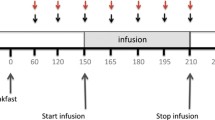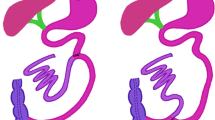Abstract
Liquid diet (LD) is known to be protective against indomethacin-induced enteropathy, which is thought to be associated with ischemic change. We tested the hypothesis that the solid component of diet modulates small intestinal blood flow (SIBF) following indomethacin administration. In the first experiment, male Wistar rats were divided into 18-hr-fasted and normal diet groups. Indomethacin (20 mg/kg) or vehicle was administered intracolonically. SIBF was measured on both the mesenteric and antimesenteric sides of the intestine, using the hydrogen gas clearance method. In the second experiment, rats were given LD alone or LD with increasing concentration of soluble/insoluble fiber for seven days. The baseline SIBF was significantly higher in the groups with normal diet and LD with fiber than in the fasting and LD groups. Following indomethacin administration, SIBF gradually decreased in the groups with normal diet and LD with insoluble fiber, while neither liquid diet nor fasting reduced SIBF. There was no difference in SIBF between the mesenteric and antimesenteric sides of the intestine in any group. Our findings suggest that solid components of diet increase basal SIBF and decrease SIBF following indomethacin administration.
Similar content being viewed by others
REFERENCES
Bjarnason I, Hayllar J, MacPherson AJ, Russell AS: Side effects of non-steroidal anti-inflammatory drugs on the small and large intestine in humans. Gastroenterology 104:1832–1847, 1993
Robert A, Asano T: Resistance of germ free rats to indomethacin-induced intestinal lesions. Prostaglandins 14:333–341, 1977
Satoh H, Guth PL, Grossman MI: Role of bacteria in gastric ulceration produced by indomethacin in the rat: Cytoprotective action of antibiotics. Gastroenterology 84:483–489, 1983
Reuter BK, Davies NM, Wallace JL: Nonsteroidal antiinflammatory drug enteropathy in rats: role of permeability, bacteria, and enterohepatic circulation. Gastroenterology 112:109–117, 1997
Wax J, Clinger WA, Varner P, Bass P, Winder CV: Relationship of the enterohepatic cycle to ulcerogenesis in the rat small bowel with flufenamic acid. Gastroenterology 58:772–780, 1970
Satoh H, Inada I, Hirata T, Maki Y: Indomethacin produces gastric antral ulcers in the refed rat. Gastroenterology 81:719–725, 1981
Satoh H, Paul H, Morton IG: Role of food in gastrointestinal ulceration produced by indomethacin in the rat. Gastroenterology 83:210–215, 1982
Matsumoto T, Iida M, Nakamura S, Hizawa K, Kuroki F, Fujishima M: An animal model of longitudinal ulcers in the small intestine induced by intracolonically administered indomethacin in rats. Gastroenterol Jpn 28:10–17, 1993
Matsumoto T, Iida M, Kuroki F, Hizawa K, Koga H, Fujishima M: Effect of diet on experimentally induced intestinal ulcers in rats: Morphology and tissue leukotrienes. Gut 35:1058–1063, 1994
Whittle BJR: Mechanism underlying gastric mucosal damage induced by indomethacin and bile-salts, and the actions of prostaglandins. Br J Pharmacol 60:455–460, 1977
Ashley SW, Sonnenschein LA, Cheung LY: Focal gastric mucosal blood flow at the site of aspirin-induced ulceration. Am J Surg 149:53–59, 1985
Kitahora T, Guth PH: Effect of aspirin hydrochloric acid on the gastric mucosal microcirculation. Gastroenterology 93;810–817, 1987
Arakawa T, Nakamura H, Chono S, Satoh H, Fukuda T, Saek Y, Kobayashi K: Absence of effect of 16,16-dimethyl prostaglandin E2 on reduction of gastric mucosal blood flow caused by indomethacin in rats. Dig Dis Sci 34:1369–1373, 1989
Lu YF, Mizutani M, Neya T, Nakayama S: Indomethacin-induced lesion modifies contractile activity in rat small intestines. Scand J Gastroenterol 30:445–450, 1995
Takeuchi K, Okada M, Niida H, Okabe S: Possible mechanisms involved in gastric hypermotility caused by indomethacin in the rat: role of glycoprivic response. Dig Dis Sci 35:984–992, 1990
Brodie DA, Cook PG, Bauer BJ: Indomethacin-induced intestinal lesions in the rat. Toxicol Appl Pharmacol 17:615–624, 1970
Fang W, Broughton A, Jacobson ED: Indomethacin-induced intestinal inflammation. Dig Dis Sci 22:749–760, 1977
Wallace JL, Keenman CM, Granger DN: Gastric ulceration induced by nonsteroidal anti-inflammatory drugs is a neutrophil-dependent process. Am J Physiol 259:G462–467, 1990
Brand JS, Morise Z, Tagerud S, Mazzola L, Granger DN, Grisham MB: Role of the proteasome in rat indomethacininduced gastropathy. Gastroenterology 116:865–873, 1999
Newberry RD, Stenson WF, Lorenz RG: Cyclooxygenase-2-dependent arachidonic acid metabolites are essential modulators of the intestinal immune response to dietary antigen. Nature Med 5:900–906, 1999
Anthony A, Dhillon AP, Nygard G, Hudson M, Piasecki C, Strong P, Trevethick MA, Clayton NM, Jordan CC, Pounder RE, Wakefield AJ: Early histological features of small intestinal injury induced by indomethacin. Aliment Pharmacol Ther 7:29–40, 1993
Nygard G, Anthony A, Piasecky C, Trevethick MA, Hudson M, Dhillon AP, Pounder RY, Wakefield AJ: Acute indomethacininduced jejunal injury in the rat: early morphological and biochemical changes. Gastroenterology 106:567–575, 1994
Anthony A, Dhillon AP, Thrasivoulou C, Pounder RE, Wakefield AJ: Pre-ulcerative villous contraction and microvascular occlusion induced by indomethacin in the rat jejunum: A detailed morphological study. Aliment Pharmacol Ther 9:605–613, 1995
Anthony A, Sim R, Dhillon AP, Pounder RE, Wakefield AJ: Gastric mucosal contraction and vascular injury induced by indomethacin precede neutrophil infiltration in the rat. Gut 39:363–368, 1996
Battarbee HD, Grisham MB, Johnson GG, Zavecz JH: Superior mesenteric artery blood flow and indomethacin-induced intestinal injury and inflammation. Am J Physiol 271:G605–G612, 1996
Ligumsky M, Sestieri M, Karmeli F, Zimmerman J, Okon E, Rachmilewitz D: Rectal administration of nonsteroidal antiin-flammatory drugs-effect on rat gastric ulcerogenicity and prostaglandin E2 synthesis. Gastroenterology 98:1245–1249, 1990
Aukland K, Bower BF, Berliner RW: Measurements of local blood flow with hydrogen gas. Circ Res 14:164–187, 1964
Gallavan RH Jr, Chou CC: Possible mechanisms for the initiation and maintenance of postprandial intestinal hyperemia. Am J Physiol 249:G301–G308, 1985
Chou CC, Grassmick B: Motility and blood flow distribution within the wall of the gastrointestinal tract. Am J Physiol 235:H34–H39, 1978
Alemany CA, Stonestreet BS: Effect of nitric oxide synthesis inhibition on mesenteric perfusion in young pigs. Am J Physiol 272:G612–G616, 1997
Gallavan RH Jr, Chou CC: Prostaglandin synthesis inhibition and postprandial intestinal hyperemia. Am J Physiol 242:G140–G146, 1982
Proctor KG: Differential effect of cyclooxygenase inhibitors on absorptive hyperemia. Am J Physiol 249:H755–H762, 1985
Chou CC, Alemayehu A, Mangino MJ: Prostanoids in regulation of postprandial jejunal hyperemia and oxygen uptake. Am J Physiol 257:G798–G808, 1989
Goto H, Kanamori S, Hayakawa T, Sugiyama S, Ozawa T: Effect of dietary fiber on prostanoid concentrations in cecal mucosa of rats. Biochem Mol Biol Int 38:437–443, 1996
Holm L, Jagare A: Influence of tactile stimulation of the rat gastric mucosa on blood flow and acid output. Am J Physiol 265:G303–G309, 1993
Ellis PR, Roberts FG, Low AG, Morgan LM: The effect of high-molecular-weight guar gum on net apparent glucose absorption and net apparent insulin and gastric inhibitory polypeptide production in the growing pig: Relationship to rheological changes in jejunal digesta. Br J Nutr 74:539–556, 1995
Anthony A, Pounder RE, Dhillon AP, Wakefield AJ: Vascular anatomy defines sites of indomethacin-induced jejunal ulceration along the mesenteric margin. Gut 41:763–770, 1997
Author information
Authors and Affiliations
Rights and permissions
About this article
Cite this article
Yamamoto, C., Kawakubo, K., Aoyagi, K. et al. Effect of Diet on Changes in Small Intestinal Blood Flow Following Intracolonic Administration of Indomethacin to Rats. Dig Dis Sci 46, 200–207 (2001). https://doi.org/10.1023/A:1005529016641
Issue Date:
DOI: https://doi.org/10.1023/A:1005529016641




